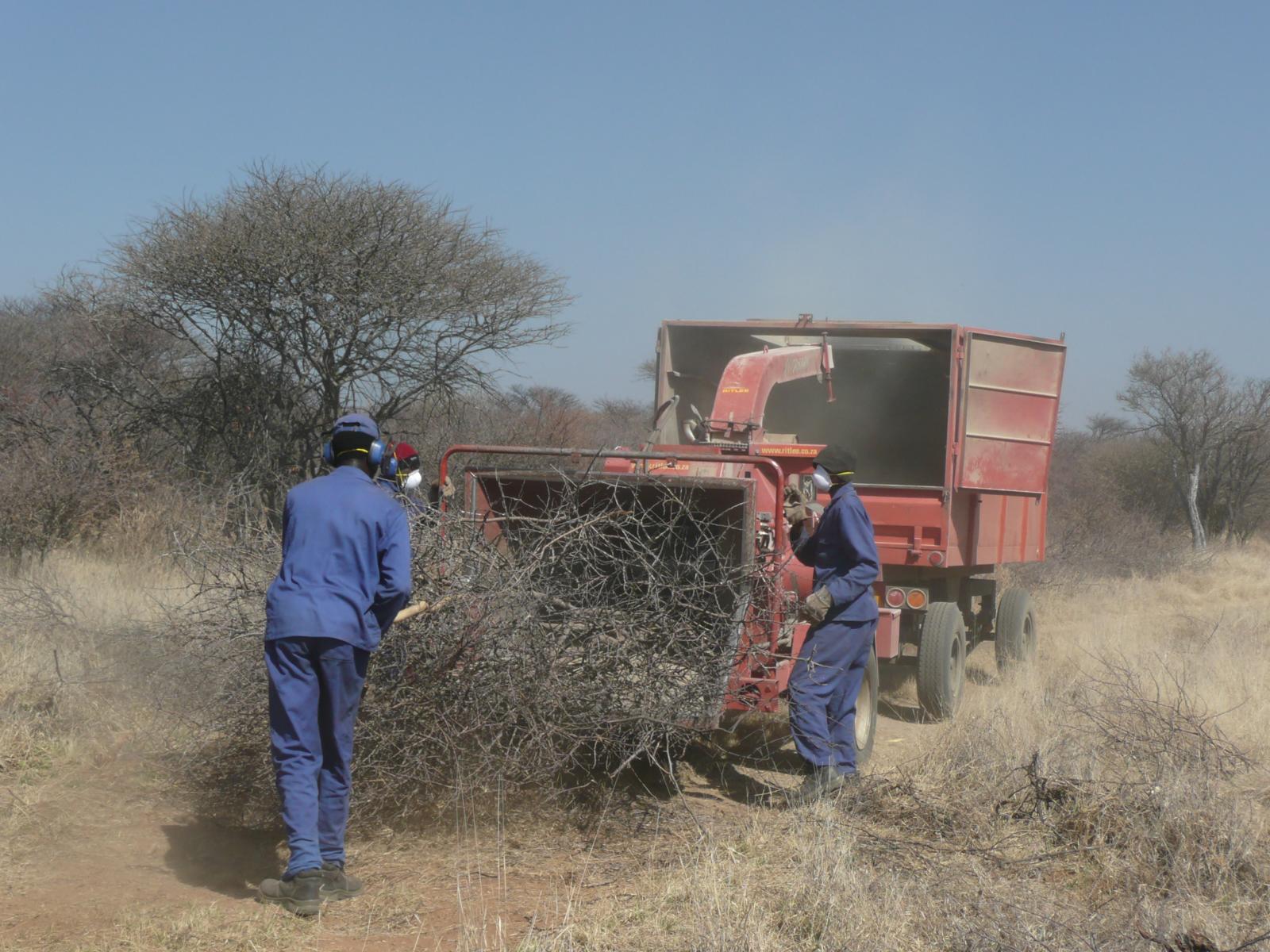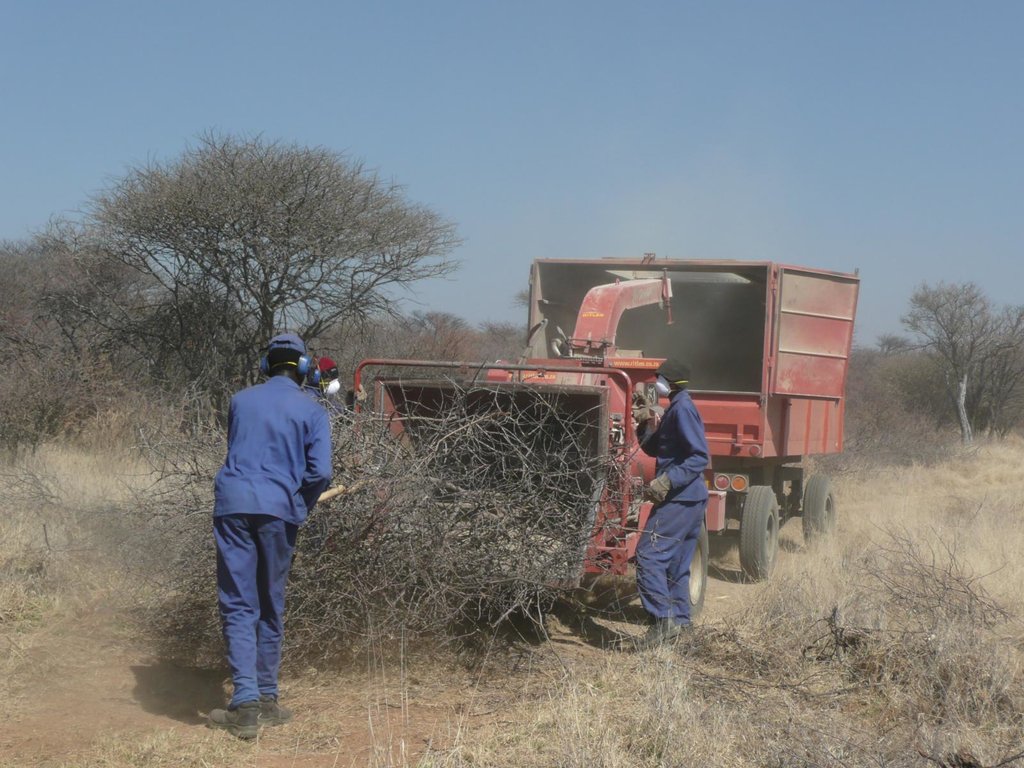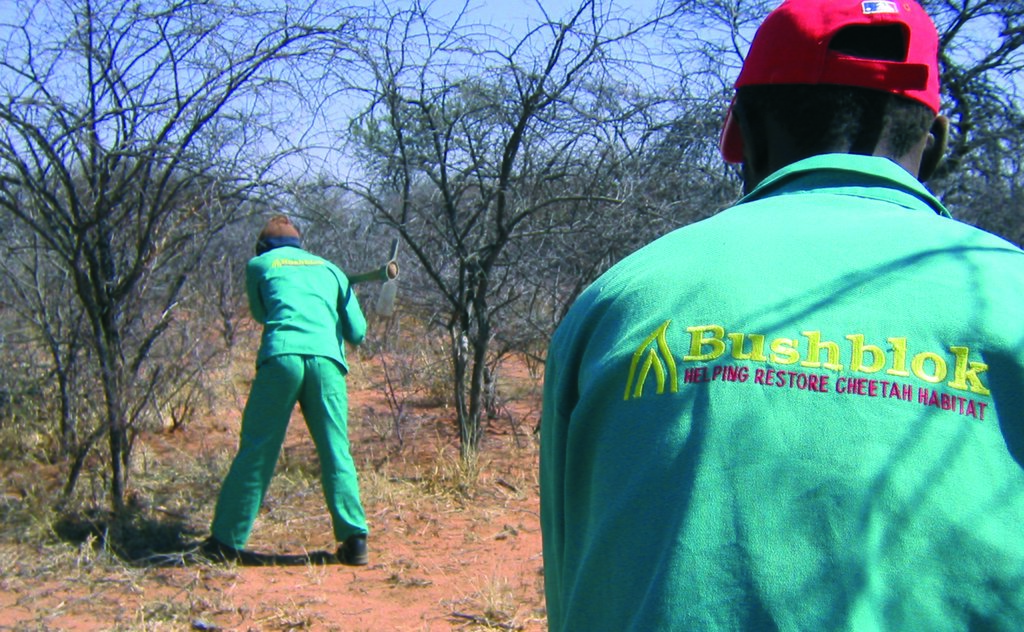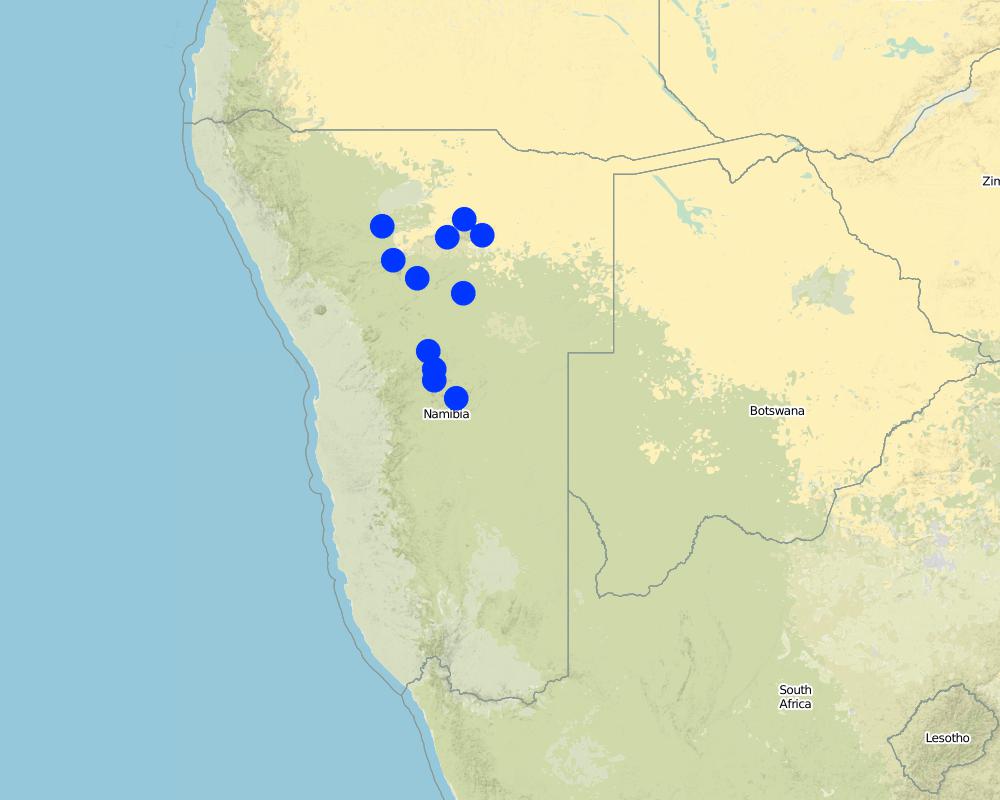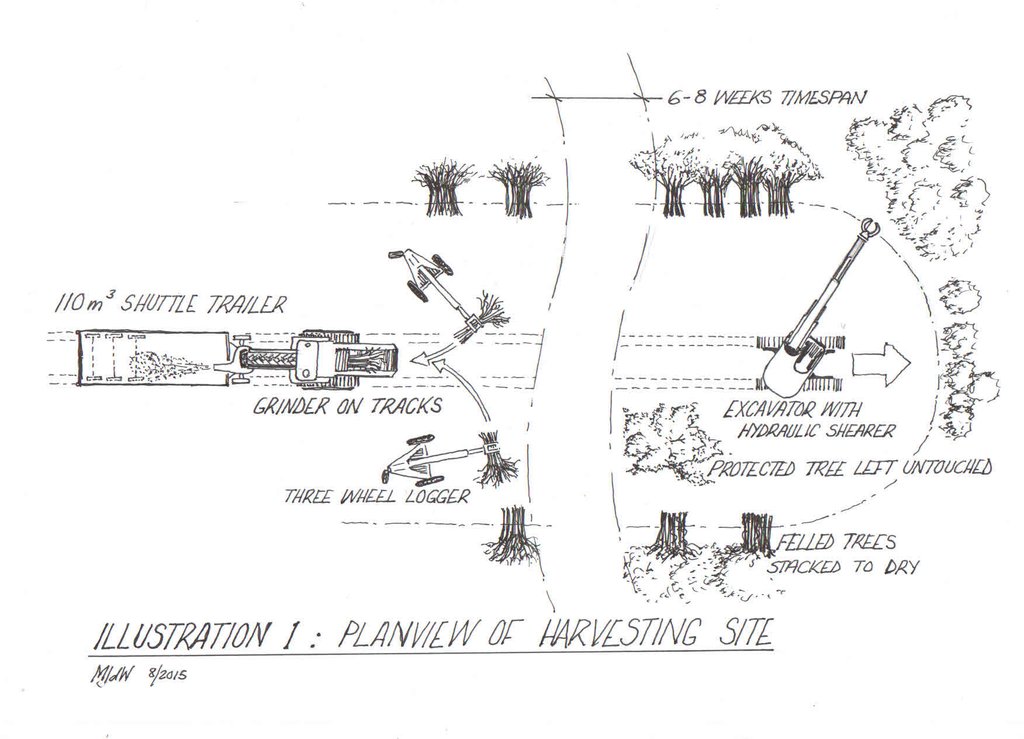Bush Thinning and Biomass Processing by Manual or Mechanised Means [Намиби]
- Шинийг нээх:
- Шинэчлэх:
- Эмхэтгэгч: Johannes Laufs
- Хянан тохиолдуулагч: Asellah David
- Хянагчид: Donia Mühlematter, Simone Verzandvoort, Rima Mekdaschi Studer, Alexandra Gavilano
Bush Thinning
technologies_2203 - Намиби
- Бүрэн хураангуйн PDF хувилбар
- Бүрэн хураангуйг PDF-ээр хэвлэх
- Хөтөч дэх бүрэн хураангуй
- Бүрэн хураангуй (форматгүй)
- Bush Thinning and Biomass Processing by Manual or Mechanised Means: 17 7-р сар 2018 (inactive)
- Bush Thinning and Biomass Processing by Manual or Mechanised Means: 31 5-р сар 2019 (inactive)
- Bush Thinning and Biomass Processing by Manual or Mechanised Means: 22 8-р сар 2017 (inactive)
- Bush Thinning and Biomass Processing by Manual or Mechanised Means: 02 11-р сар 2021 (public)
- Bush Thinning and Biomass Processing by Manual or Mechanised Means: 21 2-р сар 2018 (inactive)
Бүлгүүдийг үзэх
Бүгдийг дэлгэх Бүгдийг хаах1. Ерөнхий мэдээлэл
1.2 Технологийг үнэлэх, баримтжуулах ажилд хамаарах мэдээлэл өгсөн хүмүүс, байгууллагуудын холбоо барих мэдээлэл
ГТМ мэргэжилтэн:
Gschwender Frank
Технологи баримтжуулах/үнэлэх ажилд дэмжлэг үзүүлсэн төслийн нэр (шаардлагатай бол)
GIZ Support to De-bushing ProjectТехнологи баримтжуулах/үнэлэх ажилд дэмжлэг үзүүлсэн байгууллага(ууд)-ын нэр (шаардлагатай бол)
Deutsche Gesellschaft für Internationale Zusammenarbeit (GIZ)1.3 ВОКАТ-аар баримтжуулсан өгөгдлийг ашиглахтай холбоотой нөхцөл
Эмхэтгэгч болон гол мэдээлэгч хүн(хүмүүс) WOCAT аргачлалаар баримтжуулсан мэдээллийг ашиглахтай холбоотой нөхцлийг хүлээн зөвшөөрсөн:
Тийм
1.4 Технологи тогтвортой гэдгийг баталгаажуулах
Энэ технологийг газрын доройтлыг бууруулж, газрын тогтвортой менежментийг хангахад тохиромжтой гэж үзэж болох уу?
Үгүй
Тайлбар:
The technology described is a means to rehabilitate degraded rangeland. Through targeted harvesting of bushes, the bush density is reduced, allowing for better growth of grass.
2. ГТМ Технологийн тодорхойлолт
2.1 Технологийн товч тодорхойлолт
Технологийн тодорхойлолт:
In Namibia, excess bush is harvested to reduce competition with other plants, especially grasses. Bush can be thinned manually (e.g. with axes), semi-mechanised (e.g. chainsaws) or fully mechanised (e.g. customised equipment). After cutting, the bush is left to dry and then processed into chips or other products.
2.2 Технологийн дэлгэрэнгүй тодорхойлолт
Тодорхойлолт:
Bush thinning is carried out in Namibia to restore degraded rangeland by stimulating the re-growth of grasses – which are suppressed by excess bush. About 30-45 million hectares are affected by bush encroachment, and this affects biodiversity, groundwater recharge and the carrying capacity of rangeland. There are many causes of bush encroachment, including overgrazing and reduced frequency of wildfires. Most bush encroachment involves indigenous, rather than invasive, species.
While natural transitions in the ecosystems may lead to reductions in bush encroachment, active rehabilitation measures are required for the short-term improvements. This is an absolute necessity for many farmers, who experience severe economic difficulties due to the reduced productivity of their rangeland.
Bush control comprises responsive measures (bush thinning), follow-up measures (aftercare) as well as preventative measures (good rangeland management). Since vast areas of Namibian rangeland are heavily encroached by bush, the focus is currently on bush thinning. This entails selective harvesting of bush. To determine the density of bush remaining after thinning, a formula based on tree equivalent (TE) and average annual rainfall is used. One TE is defined as a woody tree or bush of 1.5 metres in height.
As rule of thumb for attaining optimal bush density, about 30-35% of encroacher biomass should be removed. This is based on research carried out mainly in South Africa, measuring and comparing the re-growth after bush removal. Where too much bush was removed, this often resulted in even heavier encroachment.
Bush thinning follows strict environmental guidelines set by the Directorate of Forestry (DoF) through the Forestry Act and the Directorate of Environmental Affairs (DEA) through the Environmental Management Act. This governs the equipment used (to avoid soil disturbance) and the amount of bushes harvested (to achieve a healthy number of the desired bush species). The amount of bushes to be harvested is determined by an expert and depends on various factors.
While there is a lack of precise knowledge on the long-term effect of bush thinning, there is no doubt that control has an overall positive effect on the savannah ecosystem in Namibia. The need is widely recognised among land owners and acknowledged on the national political agenda.
To render bush thinning economically feasible, value chains have been developed. Through processing and utilisation of the woody biomass, income can be generated. Processed bush biomass can, for example in the form of chips, can be used for thermal and electrical energy applications (e.g. local biomass power plants or biomass boilers for industry). Currently two such energy installations exist in Namibia, one at a local brewery and one at a local cement factory. In addition, the national power utility NamPower currently considers the construction of a 20-40 MW biomass power plant.
Other existing value chains include the production of charcoal, firewood, poles, as well as bush -based animal feed. Further value chains under consideration include composite materials, such as wood-plastic, as well as biochar.
Scientific observations have shown, that bush thinning requires regular follow-up. These measures (“aftercare”) include the prevention of coppicing and re-growth. This can be achieved by applying aboricides selectively to the cut stems, stem fires or the introduction of browsers (e.g. goats). Research on the effectiveness and possible side effects of each of these methods is limited.
A major challenge is the limited suitability of available machines. The process leads to high wear and tear on the equipment (both harvesting and processing technology, (like chippers and pelletisers), often rendering operations unprofitable. Research into, and development of, more suitable machinery is necessary. Other requirements are improved skills training and continuous monitoring of the long-term effects on rangeland.
2.3 Технологийн гэрэл зураг
Гэрэл зурагтай холбоотой ерөнхий тэмдэглэл:
All photos have either been taken by the GIZ Support to De-bushing Project or were provided to the project by third parties.
2.4 Технологийн дүрс бичлэг
Тайлбар, товч тодорхойлолт:
https://www.youtube.com/watch?v=859GshR9hso&t=3s
Bush Encroachment in Namibia: Causes and Extent
An explanation of the root causes of bush encroachment and its impact on land in Namibia.
Он, сар, өдөр:
01/11/2015
Байршил:
Namibia
Зураглаачийн нэр:
GIZ Support to De-bushing Project
Тайлбар, товч тодорхойлолт:
https://www.youtube.com/watch?v=bmlzPDiqlxo&t=45s
Biomass Value Addition: Bush Based Products
An overview of existing and potential value chains based on encroacher bush.
Он, сар, өдөр:
01/11/2015
Байршил:
Namibia
Зураглаачийн нэр:
GIZ Support to De-bushing Project
Тайлбар, товч тодорхойлолт:
https://www.youtube.com/watch?v=MMSOfV2KBjA
Biomass Energy: From Bush to Electricity
Overview of the energetic applications of woody biomass from encroacher bush.
Он, сар, өдөр:
01/11/2015
Байршил:
Namibia
Зураглаачийн нэр:
GIZ Support to De-bushing Project
2.5 Энэ үнэлгээнд хамрагдсан технологийг хэрэгжүүлсэн улс орон/ бүс нутаг/ байршил
Улс:
Намиби
Байршлын дэлгэрэнгүй тодорхойлолт:
Bush control is applied across Namibia on many privately owned farms. Activities are most concentrated in the regions Khomas, Omaheke, Otjozondjupa and Oshikoto.
Технологи өргөн дэлгэрсэн эсхийг тодорхойл:
- газар дээр жигд тархсан
Технологи газар нутгийн хэмжээнд жигд тархсан бол түүний эзлэх талбайг тодорхойлно уу (км2-аар):
1200.0
Хэрэв талбайн хэмжээ тодорхойгүй бол талбайн хэмжээг ойролцоогоор тодорхойлно уу:
- 1,000-10,000 км2
Тайлбар:
Pointers on the map only indicate points (e.g. urban centres) around which activities are concentrated. It is not possible to depict each site where bush control is implemented due to the high number of individual activities and projects.
Currently bush thinning is implemented on a total of approximately 120.000 hectares (1.200 km2) of farmland per annum. These activities are not confied to certain areas, but spread across all of Namibia, typically concentrating in the most encroached areas (e.g. Otjozondjupa, Khomas, Oshikoto and Omaheke regions).
Map
×2.6 Хэрэгжсэн хугацаа
Хэрэгжүүлсэн он:
2015
2.7 Технологийн танилцуулга
Технологийг хэрхэн нэвтрүүлснийг тодорхойл:
- Газар ашиглагчдын санаачилгаар
- Туршилт/судалгааны үр дүн
- Гадны төсөл/хөтөлбөрийн дэмжлэгтэйгээр
Тайлбар (төслийн төрөл г.м.):
Since the 1950s the phenomenon of bush encroachment has been recognised by farmers in Namibia and counter measures have been implemented over the decades. The technologies applied largely relied on the means and innovative capabilities of the respective land owner. Only as of 2014, through the introduciton of a national Support to De-bushing Project, are technologies systematically researched and tested in the field.
3. ГТМ технологийн ангилал
3.1 Технологийн үндсэн зорилго (ууд)
- үйлдвэрлэлийг сайжруулах
- газрын доройтлыг бууруулах, сэргийлэх, нөхөн сэргээх
- экосистемийг хамгаалах
- биологийн төрөл зүйлийг хамгаалах / сайжруулах
- үр ашигтай эдийн засгийн нөлөөг бий болгох
3.2 Технологи нэвтрүүлсэн газрын одоогийн газар ашиглалтын хэлбэр(үүд)

Бэлчээрийн газар
Бэлчээрийн мал аж ахуй:
- Ранч
Амьтдын төрөл зүйл:
- ямаа
- cattle
Тайлбар:
Main animal species and products: Cattle, goats, game
Namibia is characterised by large commercial cattle farms. Du to its aridity the land is largely unsuitable for crop farming, with exceptions in high-rainfall areas such as the Grootfontein, Tsumeb, Otavi triangle.
The Northern parts of Namibia are managed as communal land, where farmers have lease holds for their land. In these areas a combination of millet production and cattle herding is common.
Number of growing seasons per year: 1
Livestock density: 284 000 in targeted area (105460km2) of bush thinning (Otjozondjupa region).
3.3 Технологи хэрэгжүүлснээр газар ашиглалтад өөрчлөлт гарсан уу?
Технологи хэрэгжүүлснээр газар ашиглалтад өөрчлөлт гарсан уу?
- Тийм (Технологи хэрэгжүүлэхээс өмнөх үеийн газар ашиглалтын талаархи асуулгыг бөглөнө үү)
Тайлбар:
The implementation of bush thinning allows to maintain the land use (e.g. cattle ranching) and is typically applied to increase productivity in the long-term.
3.4 Усан хангамж
Технологи хэрэгжүүлсэн газрын усан хангамж:
- Байгалийн усалгаатай
3.5 Технологи ГТМ-ийн аль бүлэгт хамаарах вэ
- Бэлчээрийн мал аж ахуй ба бэлчээрийн газрын менежмент
- хөрс/ ургамлын бүрхэвч сайжруулах
3.6 Технологийг бүрдүүлэх ГТМ арга хэмжээ

Ургамлын арга хэмжээ
- V4: Харийн/ түрэмгий зүйлийг солих, зайлуулах

Менежментийн арга хэмжээ
- М2: Ашиглалтын менежмент/эрчимийг өөрчлөх
- M5: Төрөл зүйлийн бүтцийн өөрчлөлт/хяналт
3.7 Технологид харгалзах газрын доройтлын төрөл

биологийн доройтол
- Bh: Амьдрах орчин доройтох
- Bq: биомасс буурах
- Bs: Ургамлын чанар, төрөл зүйл, олон янз байдал буурах
3.8 Газрын доройтлоос урьдчилан сэргийлэх, сааруулах ба нөхөн сэргээх
Газрын доройтолтой холбоотойгоор Технологи ямар зорилго тавьсан болохыг тодорхойл:
- газрын доройтлоос урьдчилан сэргийлэх
- Хүчтэй доройтсон газрыг нөхөн сэргээх/ сайжруулах
4. Техникийн нөхцөл, хэрэгжүүлсэн үйл ажиллагаа, материал ба зардал
4.1 Технологийн техник зураг
Техник тодорхойлолт (техник зургийн тайлбар):
Drawing of a bush harvesting site layout. The drawing depicts fully mechanised bush harvesting and immediate processing into wood chips. This set-up is most suitable for large-scale bush thinning, e.g. for the purpose of supplying biomass in larger quantities. Such off-take includes the potential export of bush in processed form (pellets) or energetic utilisation (e.g. local biomass power plants or biomass boilers in the industry). Currently two such energy solutions exist in Namibia, one at a local brewery and one at a local cement factory.
Note that a range of bush harvesting methods exist, ranging from fully mechanised (as depicted) to manual bush harvesting (e.g. with axes). The site layout and principles are the same in all scenarios, but harvesting speed and costs differ.
The bush harvesting process:
Bushes are harvested selectively with and excavator, to which a hydraulic sheer cutter is attached. The biomass is stacked in rows and left for drying some six to eight weeks (depending on weather conditions). The biomass is then further processed with a chipper and collected with a trailer for further transport off the farm (e.g. to a biomass power plant or industrial off-taker). As a rule of thumb, one third of the standing biomass is removed, leaving two thirds standing. Harvesting starts with smaller plants and then moves to larger ones, cutting only plants with 15 centimetres of diameter or less (as per Namibian forestry regulations).
Зохиогч:
M.J. de Wet Pr. Eng., NRGen Advisors (Pty) LTD
Он, сар, өдөр:
18/09/2015
4.2 Материал болон зардалд хамаарах ерөнхий мэдээлэл
Үнэ өртөг, оруулсан хувь нэмрийг хэрхэн тооцсоныг тодорхойл:
- Технологийн нэгж тус бүр
Талбайн хэмжээ ба нэгжийг тодорхойл:
1 hectare
бусад/үндэсний мөнгөн нэгж (тодорхойл):
Namibia Dollar (NAD)
Хэрэв боломжтой бол үндэсний валютын Америк доллартай харьцах харьцааг бичнэ үү (тухайлбал, 1 ам.дол. = 79,9 Бразил реал): 1 ам.дол. =:
0.078
Хөлсний ажилчны нэг өдрийн цалингийн хэмжээг тодорхойлно уу:
Namibia Dollar (NAD) 110
4.3 Бий болгох үйл ажиллагаа
| Үйл ажиллагаа | Хугацаа (улирал) | |
|---|---|---|
| 1. | Bush harvesting/felling | Year around |
| 2. | Stacking (and drying) | Year around |
| 3. | Feeding the chipping operation | Year around |
| 4. | Transport | Year around |
Тайлбар:
The restorative measure includes bush harvesting/felling as well as aftercare measures. Additional activities include the processing (e.g. into chips) and transport of the woody material off the farm/land.
4.4 Бий болгоход шаардагдсан зардал, хөрөнгийн өртөг
| Зардлын нэр, төрөл | Хэмжих нэгж | Тоо хэмжээ | Нэгжийн үнэ | Зардал бүрийн нийт өртөг | Нийт дүнгээс газар ашиглагчийн төлсөн % | |
|---|---|---|---|---|---|---|
| Хөдөлмөр эрхлэлт | 1 x Mechanic | person days | 0.2 | 2000.0 | 400.0 | |
| Хөдөлмөр эрхлэлт | 4 x Operators | person days | 0.8 | 300.0 | 240.0 | |
| Хөдөлмөр эрхлэлт | 1 x Operation manager chipping | person days | 0.2 | 1000.0 | 200.0 | |
| Хөдөлмөр эрхлэлт | 1 x Chipping operator | person days | 2.0 | 150.0 | 300.0 | |
| Тоног төхөөрөмж | 1 x 12t Excavator | pieces | 1.0 | 120.0 | 120.0 | |
| Тоног төхөөрөмж | 2 x Hydraulic grab and shearing attachments | pieces | 2.0 | 60.0 | 120.0 | |
| Тоног төхөөрөмж | 2 x Three wheel loggers | pieces | 2.0 | 180.0 | 360.0 | |
| Тоног төхөөрөмж | 1 x Chipper | pieces | 1.0 | 840.0 | 840.0 | |
| Бусад | Management and administration overhead | lump sum | 1.0 | 200.0 | 200.0 | |
| Бусад | 12.0 | |||||
| Технологи бий болгох нийт үнэ өртөг | 2780.0 | |||||
| Технологи бий болгох нийт үнэ өртөг, ам.доллар | 35641.03 | |||||
Тайлбар:
Cost of bush harvesting can be calculated per hectare (e.g. land owner's perspective) or per tonne (in fuel supply agreements with off-takers). All given costs are approximations, as costs vary widely depending on the local framework conditions on a given piece of land. Typically the costs to harvest and process bush on one hectare range from 2,000 NAD to 4,000 NAD.
4.5 Арчилгаа/ урсгал үйл ажиллагаа
| Үйл ажиллагаа | Хугацаа/ давтамж | |
|---|---|---|
| 1. | Aftercare | Annually |
Тайлбар:
When land is thinned it creates a vacuum in which weeds and woody plants (sometimes more aggressive colonisers than the original encroacher species) will quickly establish themselves. Regular aftercare needs to be applied in order to prevent the excessive re-growth of bush (and therewith new degradation of the land). Various methods are in use to manage the re-growth of bush following harvesting. These include selective application of arboricides, stem burning, and intensive browsing by goats or antelopes.
The more sustainable the bush harvesting itself has taken place, importantly not completely clearing larger areas of vegetation, the less likely is agressive re-growth of bush. In all bush thinning exercises it is important to leave larger bushes and trees untouched and to start by removing the smaller, less established bushes. In addition, not only individual larger bushes must be left standing, but also islands/patches of bushes, which fulfill important ecosystem services, e.g. habitat for animals.
4.6 Арчилгаа/урсгал ажилд шаардагдсан зардал, хөрөнгийн өртөг (нэг жилд)
Хэрэв зардлыг нэр төрлөөр тодорхойлох боломжгүй бол Технологийг бий болгоход зарцуулсан хөрөнгийг тоймлон оруулна уу:
500.0
Тайлбар:
Commonly aftercare is applied in form of manual application of herbicides to the cut stems, in order to prevent re-growth of the bushes.
4.7 Зардалд нөлөөлж байгаа хамгийн чухал хүчин зүйл
Өртөг, зардалд нөлөөлөх гол хүчин зүйл:
(1) Investment in machinery (if not applied manually).
(2) Maintenance of machinery (high wear and tear due to hardness of wood and high mineral content).
(3) Remoteness of farms/land from buyers/markets.
5. Байгаль ба нийгмийн нөхцөл
5.1 Уур амьсгал
Жилийн нийлбэр хур тундас
- < 250 мм
- 251-500 мм
- 501-750 мм
- 751-1,000 мм
- 1,001-1,500 мм
- 1,501-2,000 мм
- 2,001-3,000 мм
- 3,001-4,000 мм
- > 4,000 мм
Жилийн дундаж хур тунадас (хэрэв мэдэгдэж байвал), мм:
350.00
Хур тунадасны талаархи тодорхойлолт/ тайлбар:
Namibia is a semi-arid country and rainfall ranges roughly from 150-550 mm per year (rough approximation due to the vastness of the area described).
Холбогдох цаг уурын станцын нэр:
Various
Агро-уур амьсгалын бүс
- хагас хуурай
5.2 Гадаргын хэлбэр
Дундаж налуу:
- хавтгай (0-2 %)
- бага зэрэг налуу (3-5 %)
- дунд зэрэг налуу (6-10 % )
- хэвгий (11-15 %)
- налуу (16-30 %)
- их налуу (31-60 % )
- эгц налуу (>60 %)
Гадаргын хэлбэр:
- тэгш өндөрлөг / тал
- нуруу
- уулын энгэр
- дов толгод
- бэл
- хөндий
Өндрийн бүслүүр:
- 0-100 д.т.д. м.
- 101-500 д.т.д. м.
- 501-1,000 д.т.д м.
- 1,001-1,500 д.т.д м.
- 1,501-2,000 д.т.д м.
- 2,001-2,500 д.т.д. м.
- 2,501-3,000 д.т.д. м.
- 3,001-4,000 д.т.д м.
- > 4,000 д.т.д. м.
Технологи дараах асуудалд хандсан эсэхийг тодорхойл:
- хамааралгүй
5.3 Хөрс
Хөрсний дундаж зузаан:
- маш нимгэн (0-20 см)
- нимгэн (21-50 см)
- дунд зэрэг зузаан (51-80 см)
- зузаан (81-120 cм)
- маш зузаан (>120 cм)
Хөрсний бүтэц (өнгөн хөрс):
- бүдүүн/ хөнгөн (элсэрхэг)
Хөрсний бүтэц (>20 см-ээс доош):
- бүдүүн/ хөнгөн (элсэрхэг)
Өнгөн хөрсөнд агуулагдах ялзмаг:
- бага (<1 % )
5.4 Усны хүртээмж ба чанар
Гүний усны түвшин:
5-50 м
Гадаргын усны хүртээмж:
хангалтгүй/ байхгүй
Усны чанар (цэвэршүүлээгүй):
сайн чанарын ундны ус
Усны давсжилтын асуудал бий юу?
Үгүй
Энэ газар үерт автдаг уу?
Үгүй
5.5 Биологийн олон янз байдал
Зүйлийн олон янз байдал:
- Бага
Амьдрах орчны олон янз байдал:
- дунд зэрэг
5.6 Технологи нэвтрүүлсэн газар ашиглагчдын тухай мэдээлэл
Суурьшмал эсвэл нүүдлийн:
- Суурьшмал
Үйлдвэрлэлийн системийн зах зээлийн чиг баримжаа:
- худалдаа наймааны/ зах зээлийн
Бусад эх үүсвэрээс олох орлого:
- Нийт орлогын 10 %-иас доош
Чинээлэг байдлын түвшин:
- дундаж
Хувь хүн эсвэл бүлэг:
- Хувь хүн / өрх
Механикжилтын түвшин:
- механикжсан / мотортой
Хүйс:
- эмэгтэй
- эрэгтэй
Газар ашиглагчийн нас:
- дунд нас
5.7 Газар ашиглагчийн технологи нэвтрүүлсэн газрын дундаж талбайн хэмжээ
- < 0.5 га
- 0.5-1 га
- 1-2 га
- 2-5 га
- 5-15 га
- 15-50 га
- 50-100 га
- 100-500 га
- 500-1,000 га
- 1,000-10,000 га
- > 10,000 га
Энэ талбай том, жижиг, дунд алинд хамаарах вэ (орон нутгийн нөхцөлд харгалзуулна уу)?
- том-хэмжээний
Тайлбар:
Typical commercial farm size is 5.000 ha. The size increases with decreasing rainfall (towards southern Namibia).
5.8 Газар эзэмшил, газар ашиглах эрх, ус ашиглах эрх
Газар өмчлөл:
- хувь хүн, өмчийн гэрчилгээтэй
Газар ашиглах эрх:
- хувь хүн
Ус ашиглах эрх:
- хувь хүн
5.9 Дэд бүтэц, үйлчилгээний хүртээмж
эрүүл мэнд:
- ядуу
- дунд зэргийн
- сайн
боловсрол:
- ядуу
- дунд зэргийн
- сайн
техник зөвлөгөө:
- ядуу
- дунд зэргийн
- сайн
хөдөлмөр эрхлэлт (жишээ нь, ХАА-аас өөр):
- ядуу
- дунд зэргийн
- сайн
зах зээл:
- ядуу
- дунд зэргийн
- сайн
эрчим хүчний хангамж:
- ядуу
- дунд зэргийн
- сайн
зам тээвэр:
- ядуу
- дунд зэргийн
- сайн
усан хангамж ба ариутгал:
- ядуу
- дунд зэргийн
- сайн
санхүүгийн үйлчилгээ:
- ядуу
- дунд зэргийн
- сайн
6. Үр нөлөө ба дүгнэлт
6.1 Технологийн талбайд үзүүлсэн нөлөө
Нийгэм-эдийн засгийн үр нөлөө
Үйлдвэрлэл
тэжээл үйлдвэрлэл
Тайлбар/ тодорхой дурьдах:
Bush-based animal feed production has been successfully trialed and is implemented by various farmers across Namibia.
малын бүтээмж
Тайлбар/ тодорхой дурьдах:
Carrying capacity of bush controlled land increases if regular aftercare is implemented.
эрчим хүчний үйлдвэрлэл
Тайлбар/ тодорхой дурьдах:
Bush-to-electricity value chain under development. Several industrial off-takers use woody biomass for boilers (heat), the national power utility currently develops a first biomass power plant.
Усны хүртээмж ба чанар
мал услах усны хүрэлцээ
Тайлбар/ тодорхой дурьдах:
Studies show a direct positive correlation between the extent of bush control and the availability of groundwater.
Орлого, зарлага
тухайн аж ахуйн орлого
Тайлбар/ тодорхой дурьдах:
Bush based value addition, e.g. charcoal production, leads to additional income for land owners and farm workers.
орлогын олон янз эх үүсвэр
Тайлбар/ тодорхой дурьдах:
Bush based value addition, e.g. charcoal production, leads to additional income for land owners and farm workers.
Экологийн үр нөлөө
Биологийн олон янз байдал: ургамал, амьтан
газрын дээрхи / доорхи карбон
ургамлын төрөл, зүйл
түрэмгий, харь зүйл
Тайлбар/ тодорхой дурьдах:
Alien species are completely removed where possible (e.g. Prosopis).
6.3 Технологийн уур амьсгалын өөрчлөлт, цаг агаарын гамшигт үзэгдэлд өртөх байдал ба эмзэг байдал (газар ашиглагчийн бодлоор)
Уур амьсгалын аажим өөрчлөлт
Уур амьсгалын аажим өөрчлөлт
| Улирал | Өсөх эсвэл буурах | Технологи түүний нөлөөг хэрхэн бууруулж байна? | |
|---|---|---|---|
| жилийн дундаж хур тундас | Бууралт | муу |
Уур амьсгалаас хамаарах аюул (гамшиг)
Уур амьсгалын гамшиг
| Технологи түүний нөлөөг хэрхэн бууруулж байна? | |
|---|---|
| ган гачиг | маш муу |
Тайлбар:
Despite only limited research exists, long periods of drought that the country has recently faced, are credited to climate change. Drought intensifies the challenge for farmers, as already degraded rangeland has limited capacity to recover in the absence of rain. The technology of bush thinning itself has limited effect if no rain follows the removal of bushes.
6.4 Өртөг ба ашгийн шинжилгээ
Бий болгох зардалтай харьцуулахад ямар ашиг өгсөн бэ (газар ашиглагчийн бодлоор)?
Богино хугацаанд эргэн төлөгдөх байдал:
сөрөг
Урт хугацаанд эргэн төлөгдөх байдал:
маш эерэг
Арчилгаа/урсгал зардалтай харьцуулахад ямар ашиг өгсөн бэ (газар ашиглагчийн бодлоор)?
Богино хугацаанд эргэн төлөгдөх байдал:
сөрөг
Урт хугацаанд эргэн төлөгдөх байдал:
маш эерэг
Тайлбар:
Bush thinned land takes 3-5 years to fully recover its productive grass layer, thus direct economic benefits are only experienced with a delay.
6.5 Технологи нэвтрүүлэлт
- жишээ/ туршилт
Боломжтой бол, тоогоор илэрхийл (өрхийн тоо эсвэл бүрхэх талбай):
120'000 hectares are bush thinned per year in Namibia; figures on the increase
Технологи нэвтрүүлсэн хүмүүсээс хэд нь өөрийн хүчээр технологийг хэрэгжүүлсэн бэ, өөрөөр хэлбэл гадны тусламж дэмжлэг авалгүйгээр?
- 51-90%
Тайлбар:
Farmers largely implement bush control on their own initiative; increasingly value chains are being developed and dedicated service providers offer bush control.
6.6 Дасан зохицох
Бий болсон өөрчлөлтөд зохицуулан технологийг өөрчилсөн үү?
Тийм
Хэрэв Тийм бол ямар өөрчлөлтөд дасан зохицсон бэ:
- зах зээлийн өөрчлөлт
Дасан зохицох зорилгоор технологид хийсэн өөрчлөлт (хийц, материал, төрөл зүйл г.м.):
Increasingly bush harvesting is carried out with mechanised means, aiming at large scale production for large biomass off-takers, both in the country and internationally.
6.7 Технологийн давуу тал/боломжууд
| Газар ашиглагчдын тодорхойлсон давуу тал/боломжууд |
|---|
| Effective measure against bush encroachment |
| Costs can be balanced with additional income through the sale of the biomass/biomass based products |
| Эмхэтгэгч, бусад мэдээлэл өгсөн хүмүүсийн өнцгөөс тодорхойлсон давуу тал/боломжууд |
|---|
| Apart from the main purpose of rehabilitating rangeland, bush control has various side benefits, such as employment creation and industrialisation. |
| Bush control and biomass utilisation can contribute to energy security in the country. |
| The available range of technologies (from manual to fully mechanised) allows to develop viable concept for all types of land/land ownership scenarios. |
6.8 Технологийн дутагдалтай/сул тал/аюул болон тэдгээрийг хэрхэн даван туулах арга зам
| Газар ашиглагч нарын тодорхойлсон сул тал/ дутагдал/ эрсдэл | Тэдгээрийг хэрхэн даван туулах вэ? |
|---|---|
| High initial costs involved. | Development of dedicated financial products. |
| Possible negative consequences, such as more aggressive re-growth of species. | Increased knowledge dissemination, skills development and mentorship programmes. |
| Эмхэтгэгч, бусад мэдээлэл өгсөн хүмүүсийн өнцгөөс тодорхойлсон сул тал/ дутагдал/ эрсдэл | Тэдгээрийг хэрхэн даван туулах вэ? |
|---|---|
| Necessity of cross-sector collaboration, e.g. agriculture, forestry, environment, industry, energy and resulting complexity. | Introduction of effective steering body on national level. |
| Challenges to sustain operations in communal areas/on land that is not owned by individuals. | Development of concepts for community based projects and cooperation with relevant regional authorities and decision making bodies (e.g. Regional Councils, Conservancies). |
7. Ном зүй ба холбоосууд
7.1 Мэдээлэл цуглуулсан арга/эх үүсвэр
- Хээрийн уулзалт, судалгаа
De-bushing Advisory Service Demand Survey (2015), 361 respondents
- тайлан болон бусад эх сурвалжийн бүрдэл
Various
Мэдээллийг хэзээ (газар дээр нь) цуглуулсан бэ?
01/08/2014
7.2 Ном, хэвлэлийн ишлэл
Гарчиг, зохиогч, он, ISBN:
Baseline Assessment for De-bushing Programme in Namibia (2014)
Хаанаас авч болох вэ? Зардал?
GIZ Support to De-bushing Project, www.dasnamibia.org/downloads
Гарчиг, зохиогч, он, ISBN:
Demand Survey for the implementation of a De-bushing Advisory Service (2015)
Хаанаас авч болох вэ? Зардал?
GIZ Support to De-bushing Project, www.dasnamibia.org/downloads
Гарчиг, зохиогч, он, ISBN:
Value Added user-opportunities for encroacher bush (2015)
Хаанаас авч болох вэ? Зардал?
GIZ Support to De-bushing Project, www.dasnamibia.org/downloads
Гарчиг, зохиогч, он, ISBN:
Compendium of harvesting technologies for encroacher bush (2015)
Хаанаас авч болох вэ? Зардал?
GIZ Support to De-bushing Project, www.dasnamibia.org/downloads
Гарчиг, зохиогч, он, ISBN:
Assessment of biomass resource and potential yield in Namibia (2015)
Хаанаас авч болох вэ? Зардал?
GIZ Support to De-bushing Project, www.dasnamibia.org/downloads
Гарчиг, зохиогч, он, ISBN:
Strategic Environmental Assessment (SEA) on bush thinning and biomass utilisation (2015)
Хаанаас авч болох вэ? Зардал?
GIZ Support to De-bushing Project, www.dasnamibia.org/downloads
Гарчиг, зохиогч, он, ISBN:
Assesment of financial products and incentive schemes for bush harvesting and value addition (2015)
Хаанаас авч болох вэ? Зардал?
GIZ Support to De-bushing Project, www.dasnamibia.org/downloads
Гарчиг, зохиогч, он, ISBN:
Environmental and forestry bush harvesting guidelines and generic Environmental Management Plan (2016)
Хаанаас авч болох вэ? Зардал?
GIZ Support to De-bushing Project, www.dasnamibia.org/downloads
Гарчиг, зохиогч, он, ISBN:
Regional assessment of the economics of land degradation related to bush encroachment in Otjozondjupa, Namibia
Хаанаас авч болох вэ? Зардал?
GIZ Support to De-bushing Project, www.dasnamibia.org/downloads
7.3 Холбогдох мэдээллийн интернет холбоос
Гарчиг/ тодорхойлолт:
De-bushing Advisory Service (DAS) Namibia, Resource Section
URL:
www.dasnamibia.org/downloads
Гарчиг/ тодорхойлолт:
Namibia Biomass Industry Group (N-BiG)
URL:
www.n-big.org
Гарчиг/ тодорхойлолт:
Videos
URL:
https://www.youtube.com/channel/UCwCICCfwf0SdVBqg2ZcAcKA
Гарчиг/ тодорхойлолт:
Namibia Charcoal Association (NCA)
URL:
www.ncanamibia.com
Холбоос ба модулууд
Бүгдийг дэлгэх Бүгдийг хаахХолбоосууд
Холбоос байхгүй байна
Модулууд
Модуль байхгүй байна


